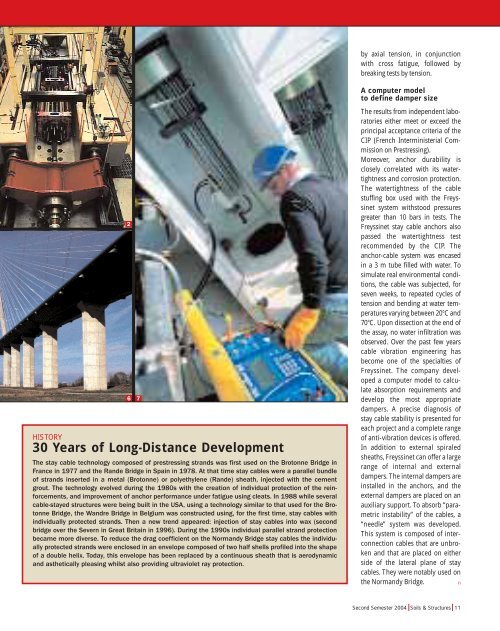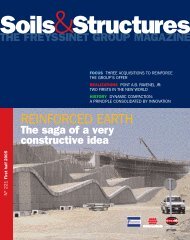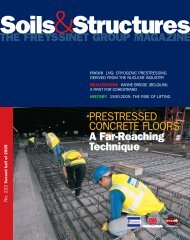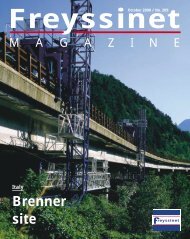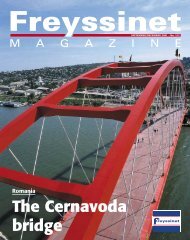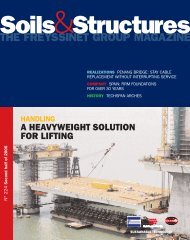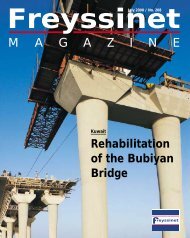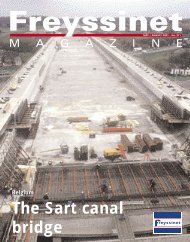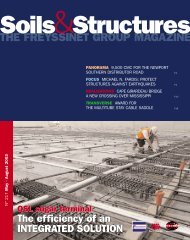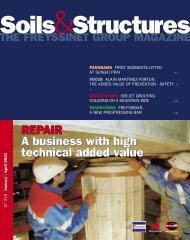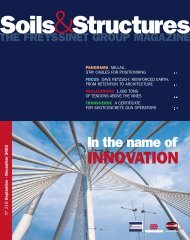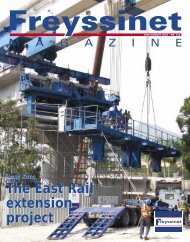STAY CABLE : The System in Top Form N°220 - Freyssinet
STAY CABLE : The System in Top Form N°220 - Freyssinet
STAY CABLE : The System in Top Form N°220 - Freyssinet
Create successful ePaper yourself
Turn your PDF publications into a flip-book with our unique Google optimized e-Paper software.
DOSSIER<br />
by axial tension, <strong>in</strong> conjunction<br />
with cross fatigue, followed by<br />
break<strong>in</strong>g tests by tension.<br />
A computer model<br />
to def<strong>in</strong>e damper size<br />
2<br />
6 7<br />
HISTORY<br />
30 Years of Long-Distance Development<br />
<strong>The</strong> stay cable technology composed of prestress<strong>in</strong>g strands was first used on the Brotonne Bridge <strong>in</strong><br />
France <strong>in</strong> 1977 and the Rande Bridge <strong>in</strong> Spa<strong>in</strong> <strong>in</strong> 1978. At that time stay cables were a parallel bundle<br />
of strands <strong>in</strong>serted <strong>in</strong> a metal (Brotonne) or polyethylene (Rande) sheath, <strong>in</strong>jected with the cement<br />
grout. <strong>The</strong> technology evolved dur<strong>in</strong>g the 1980s with the creation of <strong>in</strong>dividual protection of the re<strong>in</strong>forcements,<br />
and improvement of anchor performance under fatigue us<strong>in</strong>g cleats. In 1988 while several<br />
cable-stayed structures were be<strong>in</strong>g built <strong>in</strong> the USA, us<strong>in</strong>g a technology similar to that used for the Brotonne<br />
Bridge, the Wandre Bridge <strong>in</strong> Belgium was constructed us<strong>in</strong>g, for the first time, stay cables with<br />
<strong>in</strong>dividually protected strands. <strong>The</strong>n a new trend appeared: <strong>in</strong>jection of stay cables <strong>in</strong>to wax (second<br />
bridge over the Severn <strong>in</strong> Great Brita<strong>in</strong> <strong>in</strong> 1996). Dur<strong>in</strong>g the 1990s <strong>in</strong>dividual parallel strand protection<br />
became more diverse. To reduce the drag coefficient on the Normandy Bridge stay cables the <strong>in</strong>dividually<br />
protected strands were enclosed <strong>in</strong> an envelope composed of two half shells profiled <strong>in</strong>to the shape<br />
of a double helix. Today, this envelope has been replaced by a cont<strong>in</strong>uous sheath that is aerodynamic<br />
and asthetically pleas<strong>in</strong>g whilst also provid<strong>in</strong>g ultraviolet ray protection.<br />
<strong>The</strong> results from <strong>in</strong>dependent laboratories<br />
either meet or exceed the<br />
pr<strong>in</strong>cipal acceptance criteria of the<br />
CIP (French Interm<strong>in</strong>isterial Commission<br />
on Prestress<strong>in</strong>g).<br />
Moreover, anchor durability is<br />
closely correlated with its watertightness<br />
and corrosion protection.<br />
<strong>The</strong> watertightness of the cable<br />
stuff<strong>in</strong>g box used with the Freyss<strong>in</strong>et<br />
system withstood pressures<br />
greater than 10 bars <strong>in</strong> tests. <strong>The</strong><br />
Freyss<strong>in</strong>et stay cable anchors also<br />
passed the watertightness test<br />
recommended by the CIP. <strong>The</strong><br />
anchor-cable system was encased<br />
<strong>in</strong> a 3 m tube filled with water. To<br />
simulate real environmental conditions,<br />
the cable was subjected, for<br />
seven weeks, to repeated cycles of<br />
tension and bend<strong>in</strong>g at water temperatures<br />
vary<strong>in</strong>g between 20°C and<br />
70°C. Upon dissection at the end of<br />
the assay, no water <strong>in</strong>filtration was<br />
observed. Over the past few years<br />
cable vibration eng<strong>in</strong>eer<strong>in</strong>g has<br />
become one of the specialties of<br />
Freyss<strong>in</strong>et. <strong>The</strong> company developed<br />
a computer model to calculate<br />
absorption requirements and<br />
develop the most appropriate<br />
dampers. A precise diagnosis of<br />
stay cable stability is presented for<br />
each project and a complete range<br />
of anti-vibration devices is offered.<br />
In addition to external spiraled<br />
sheaths, Freyss<strong>in</strong>et can offer a large<br />
range of <strong>in</strong>ternal and external<br />
dampers. <strong>The</strong> <strong>in</strong>ternal dampers are<br />
<strong>in</strong>stalled <strong>in</strong> the anchors, and the<br />
external dampers are placed on an<br />
auxiliary support. To absorb “parametric<br />
<strong>in</strong>stability” of the cables, a<br />
“needle” system was developed.<br />
This system is composed of <strong>in</strong>terconnection<br />
cables that are unbroken<br />
and that are placed on either<br />
side of the lateral plane of stay<br />
cables. <strong>The</strong>y were notably used on<br />
the Normandy Bridge.<br />
n<br />
Second Semester 2004 Soils & Structures 11


